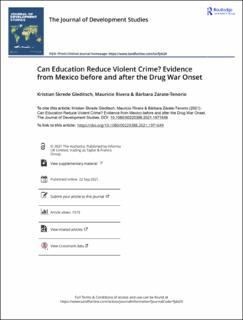| dc.contributor.author | Skrede Gleditsch, Kristian | |
| dc.contributor.author | Rivera, Mauricio | |
| dc.contributor.author | Zarate Tenorio, Barbara Astrid | |
| dc.coverage.spatial | Mexico | en_US |
| dc.date.accessioned | 2022-02-28T09:41:42Z | |
| dc.date.available | 2022-02-28T09:41:42Z | |
| dc.date.created | 2021-11-03T13:38:59Z | |
| dc.date.issued | 2021-09-22 | |
| dc.identifier.issn | 0022-0388 | |
| dc.identifier.issn | 1743-9140 | |
| dc.identifier.uri | https://hdl.handle.net/11250/2981626 | |
| dc.description.abstract | Existing theories relate higher education to lower crime rates, yet we have limited evidence on the crime-reducing effect of education in developing countries. We contribute to this literature by examining the effect of education on homicide in Mexico, where homicide rates decreased by nearly 55 percent from 1992 to 2007, before the surge of drug-related violence. We argue that a large amount of this reduction followed a compulsory schooling law at the secondary level in 1993, when the government undertook key education reforms to promote development and economic integration. We employ different empirical strategies that combine regression analysis, placebo tests, and an instrumental variable approach, and find that attendance in secondary and tertiary schools has a negative effect on homicide rates before the onset of the Drug War, although the evidence for secondary enrolment is more robust. This effect vanishes after the drug war onset, indicating that school attendance has different effects on different types of criminal activity. These findings suggest that policy makers can reduce crime and traditional forms of interpersonal violence by strengthening the education system. | en_US |
| dc.description.sponsorship | This is supported by the British Academy and the Newton Found [AF150270], the Research Council of Norway [402635], and the European Research Council [ESRC ES/S009965/1 and ES/L011859/1]. | en_US |
| dc.language.iso | eng | en_US |
| dc.publisher | Routledge | en_US |
| dc.relation.ispartofseries | Journal of Development Studies; | |
| dc.rights | Attribution-NonCommercial-NoDerivatives 4.0 Internasjonal | * |
| dc.rights.uri | http://creativecommons.org/licenses/by-nc-nd/4.0/deed.no | * |
| dc.subject | Crimes | en_US |
| dc.subject | Homicides | en_US |
| dc.subject | Education | en_US |
| dc.subject | School enrolments | en_US |
| dc.subject | Drug wars | en_US |
| dc.subject | Mexico | en_US |
| dc.title | Can Education Reduce Violent Crime? Evidence from Mexico before and after the Drug War Onset | en_US |
| dc.type | Peer reviewed | en_US |
| dc.type | Journal article | en_US |
| dc.description.version | publishedVersion | en_US |
| dc.rights.holder | © 2021 The Author(s) | en_US |
| cristin.ispublished | true | |
| cristin.fulltext | original | |
| cristin.qualitycode | 2 | |
| dc.identifier.doi | https://doi.org/10.1080/00220388.2021.1971649 | |
| dc.identifier.cristin | 1951017 | |
| dc.source.journal | Journal of Development Studies | en_US |
| dc.source.pagenumber | 1-18 | en_US |
| dc.relation.project | Norges forskningsråd: 302445 | en_US |
| dc.relation.project | Norges forskningsråd: 402635 | en_US |
| dc.relation.project | British Academy and the Newton Found: AF150270 | en_US |
| dc.relation.project | European Research Council: ES/S009965/1 | en_US |
| dc.relation.project | European Research Council: ES/L011859/1 | en_US |

